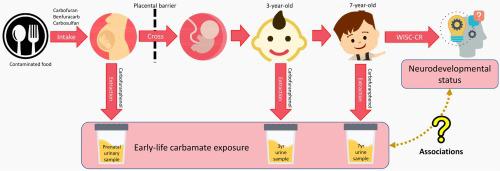Environment International ( IF 10.3 ) Pub Date : 2020-09-09 , DOI: 10.1016/j.envint.2020.106105 Jiming Zhang 1 , Jianqiu Guo 1 , Chunhua Wu 1 , Xiaojuan Qi 2 , Shuai Jiang 1 , Tong Zhou 1 , Hongxi Xiao 1 , Wenting Li 1 , Dasheng Lu 3 , Chao Feng 3 , Weijiu Liang 4 , Xiuli Chang 1 , Yubin Zhang 1 , Yang Cao 5 , Guoquan Wang 3 , Zhijun Zhou 1

|
Background
Early-life carbamate exposure during developmental period has been linked with adverse health effects and attracted attention.
Methods
Three hundred and three children at age of seven were included in the current study. Urinary carbofuranphenol concentrations were measured using gas chromatography-tandem mass spectrometry. Verbal, performance and full-scale intelligence quotients (IQV, IQP, and IQFS) were assessed using Wechsler Intelligence Scale for Children-Chinese Revised. Generalized linear models were used to explore the associations between carbofuranphenol levels and IQs. Generalized estimating equations were used to explore long-term health effect and sensitive time window.
Results
Carbofuranphenol was detected in 96.6% of the seven-year-old urinary samples, the geometric mean, median, and inter quartile range of the carbofuranphenol concentrations were 0.67 μg/L, 0.30 μg/L, and 0.09–3.72 μg/L, respectively, which were similar with the level of three-year-old children from the SMBCS cohort. Seven-year-old carbofuranphenol level was negatively associated with IQP [β = −0.044; 95% confidence interval (CI): −0.087, −0.001; p = 0.045]. Three-year-old carbofuranphenol level was negatively associated with IQP (β = −0.100; 95% CI: −0.186, −0.014; p = 0.022) and IQFS (β = −0.087; 95% CI: −0.173, −0.001; p = 0.047). Carbamate exposure of maternal and children at both three and seven years old had negative associations with IQP (β = −0.089; 95% CI: −0.171, −0.007; p = 0.034), and IQFS (β = −0.064; 95% CI: −0.127, −0.000; p = 0.049) of children at age of seven.
Conclusion
Results of the present study verify that children in an agricultural region of China were widely exposed to carbamate pesticides. Carbamate exposure in utero and at three and seven years may adversely impact children’s neurodevelopment.











































 京公网安备 11010802027423号
京公网安备 11010802027423号